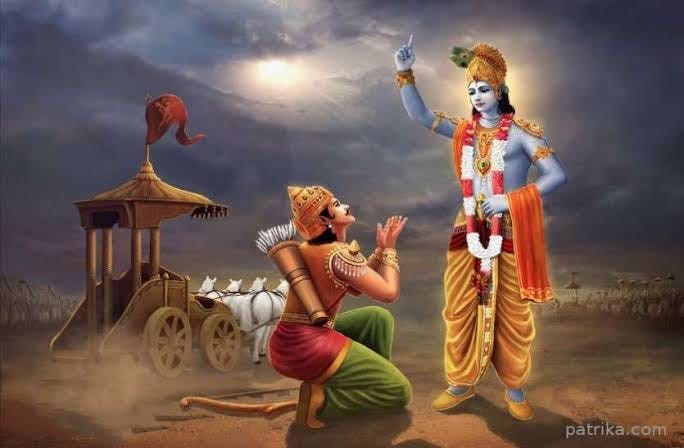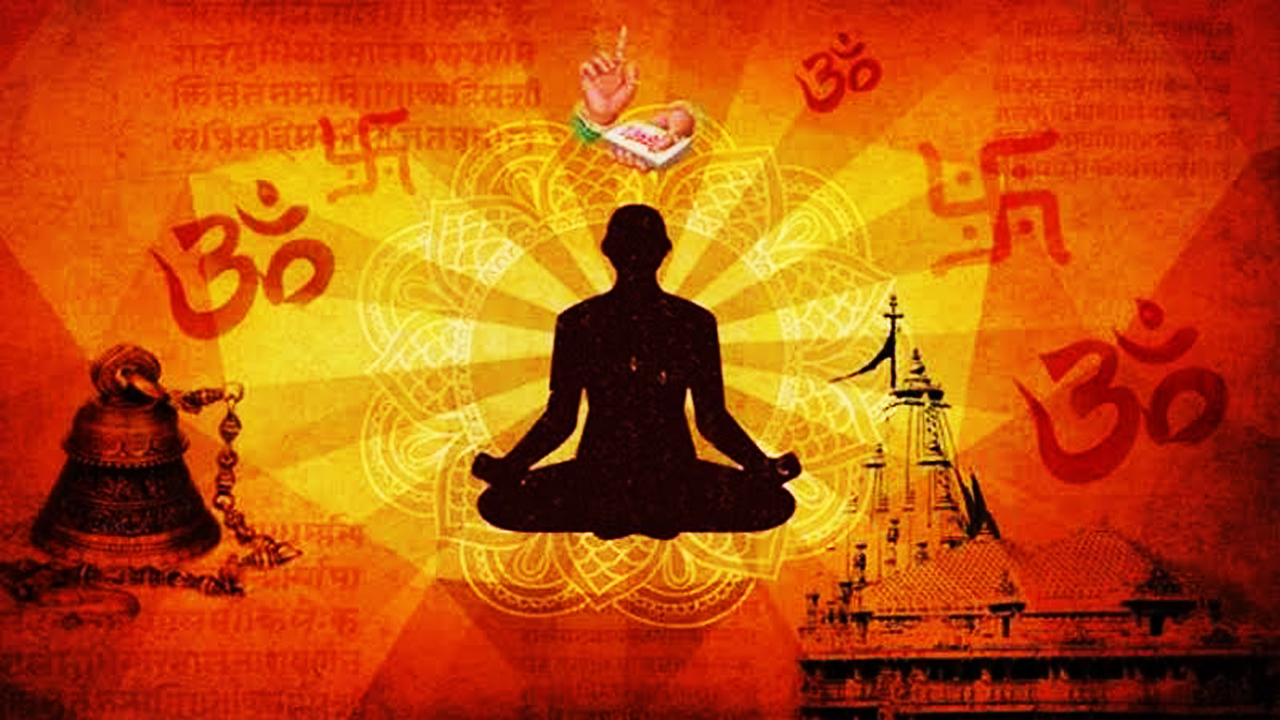
"When meditation is mastered, the mind is unwavering like the flame of a lamp in a windless place." – Bhagavad Gita 6.19

Hitherto, many individuals have endeavoured to capture the essence of Sanatana Dharma but to little avail. Some mistake it for a religion that remains fixated on its antiquated caste-system, unscientific, superstitious rituals worshipping adorned idols that seem devoid of rationality, a religion that perpetuates gender inequality and harbours doctrinal inconsistency. Some condescendingly label it and its followers as primitive, contending that its ancient texts and practices are relics of a bygone era permeated with myth, incapable of serving modern societal needs or any purpose at all. Disdainful epithets such as ‘red dots’, ‘cow worshippers’, ‘malaun’ and ‘pajeet’ are hurled derisively and scornfully to caricature the rich traditions of Sanatana Dharma while some major political and religious leaders denigrate Sanatana Dharma to diseases like malaria and dengue that should be entirely eradicated[i].
However, those who follow Sanatana Dharma know it to be peerless in the depth, grandeur and splendour of its philosophy, crafted and conformed to every human’s unique requisites, aspirations and dreams. Sanatana Dharma “is like a river again, broad and deep, shallow enough here for the lamb to go wading, but deep enough there for the elephant to swim[ii],” embracing the heartfelt yearning of every soul from the innocent child burning with curiosity to the most learned sage who even after many lifetimes of introspection finds its vastness ever elusive[1]. The deeper one plunges into its bottomless void, the more it illumines the intellect and nourishes the spirit.
In our modern hyper-consumerist age, despite unprecedented strides in the realm of material comfort, a greater understanding of the laws that govern the cosmos and economic development, a pervasive existential crisis persists—a fatal, paramount chasm. People, though surrounded by opulence and luxury, are bereft of their identity, their inner calling, their moral conscience, their happiness, leaving them adrift of direction or purpose. This crucial chasm in the social body manifests in the form of needless wars fuelled by petty matters, widespread environmental degradation with deforestation, pollution and ever-growing epidemics in mental and physical wellbeing, with more and more people suffering from anxiety, depression and loneliness. Although the social body is more interconnected and developed than ever, it is still starved of inner harmony, coherence and collective purpose.
Sanatana Dharma fills this vital cavity like no other because no way of life has studied the science of human fulfilment and happiness so profoundly as Sanatana Dharma. Sanatana Dharma offers a holistic framework that encompasses the entire spectrum of human experience—physical, mental and spiritual—through an integrative approach that seeks both divine union and external balance. Its teachings do not merely offer a set of rigid prescriptions but rather invite individuals to embark on a journey of self-inquiry and alignment with the mystic vibrations of being. It honours the diversity of temperaments and paths, allowing for both devotion and discernment, action and contemplation, tradition and evolution. Rooted in universal principles yet ever responsive to the needs of the age, it neither demands blind allegiance nor condemns questioning. Instead, it awakens an inner compass through which one may ascertain their unique dharma and live under truth, compassion and wisdom. In this way, Sanatana Dharma stands not as a relic of the past but as a luminous and living force, ever-relevant and radiant with possibility, quietly guiding seekers toward freedom, wholeness and perfection.
“That which supports, that which holds together the peoples (of the universe), that is dharma.[iii]” Sanatana in Sanskrit[2] means ‘eternal’ or ‘everlasting’. Therefore, the Sanskrit phrase ‘Sanatana Dharma’ can be loosely translated as ‘the Eternal Truth, Law or Path that binds together the people of the universe’, but even these translations fall short of capturing the profound nuance and depth carried by the original Sanskrit expression. A good classicist knows that the etymological root of the word ‘religion’ lies in the Latin verb ‘religare’, meaning ‘to bind’. In this original sense, religion is that which unites - binding the individual to the cosmos, moral order and the divine. From this etymological standpoint, religion may rightfully be regarded under the umbrella of Dharma, for one aim of Sanatana Dharma is to bind all beings to Ṛta[3] through Dharma, self-realisation and living in peaceful synchrony with nature, and this is a form of support. However, in the modern context, the term ‘religion’ has evolved to denote a more institutional, doctrinal and exclusivist framework, often marked by creeds, rigid dogma and bounded identities that divide rather than bind. Within this narrowed and modernised definition, Sanatana Dharma resists classification as a religion and religion under Dharma, for Sanatana Dharma is not merely a religion in the contemporary sense but a timeless and all-encompassing way of life—fluid, pluralistic and experiential - and neither is religion.
Sanatana Dharma is a religion that allows people to practise regardless of their faiths or beliefs (atheist, agnostic, Christian, Jew, Muslim, Buddhist, Hindu, etc.). A religion that requires no identification - no ecclesiastical papacy or possession of a certain item to prove that you are a part of the religion. A religion that does not require you to pray five times a day or mandates you to complete any type of pilgrimage. A religion that requires no conversion process because the pervasive philosophy of this religion is readily available to all, only if one endeavours to search for it.
A religion that teaches us to embody the epitome of our capabilities through the scientific discipline of yoga[4], new schools of thought and upliftment in a manner we may have never thought we could achieve before through arduous sādhana[5], inner exploration and a journey traversing the fabric of nature that surrounds us to undoubtedly end in consummation, beatitude and self-realisation.
A religion that does not have a single holy book or a consistent notion about what is good or bad or right path but encourages you to find your own individual, unique and extraordinary path by immersing oneself deeper and deeper into the reservoirs of wisdom among the Vedas, the Upanishads, the Puranas, the Itihasas. A religion with no single founder, no definitive beginning or end—it is everlasting, endless, eternal.
A religion that is not defined by dogmas, hard-lined boundaries or doctrines. Hence, Sanatana Dharma is a way of life that is inherently free from the constraints of conventional religions and therefore transcends the modern conception of a ‘religion’ itself.
Sanatana Dharma is the very omnipresent spiritual consciousness that has always unknowingly lingered around us, eagerly waiting to be discerned, realised and embraced. It is that eternal channel between all of us to unite with the oneness of energy that has always surrounded us, offering a path of spiritual fulfilment and universal harmony. A component of our being is so integral to us that we would simply lose our identity, direction and happiness without it. The very factor that makes all of us qualitatively one in a quantum world where everything is connected and everything is fundamentally alike when peering through the single cosmic eye[6].
[i] The Hindu. 2023. Sanatana is against social justice and has to be eradicated: Udhayanidhi. 03 September. https://www.thehindu.com/news/national/tamil-nadu/sanatana-is-against-social-justice-and-has-to-be-eradicated-udhayanidhi/article67264565.ece. [ii] Gregory the Great, Moralia in Job, trans. John Henry Parker (Oxford: J.G.F. and J. Rivington, 1844), Book IV, Preface. [iii] Burke, George Abbot, ed. Sanatana Dharma: The Eternal Religion. Edited for the modern reader by Swami Nirmalananda. Originally published as Sanatana Dharma, An Advanced Text Book of Hindu Religion and Ethics. Sri Bharat Dharma Mahamandal, 1920, 7.
[1] “After many births, the wise one surrenders unto Me, knowing that Vasudeva is everything. Such a great soul is very rare.” (Bhagavad Gita 7.19) [2] Sanskrit is an ancient Indo-European language that is widely regarded as the oldest language in the world. It is the foundational language not only for all the languages of the Indian subcontinent but also for many languages within the broader Indo-European family. As the language in which the great epics like the Mahabharata, the Ramayana, and the Vedas were composed, Sanskrit holds a profound cultural, philosophical and spiritual significance. [3] Ṛta (Sanskrit: ऋत) is a foundational concept in Vedic thought, referring to the cosmic order, truth, and natural law that governs the universe. It is the principle that maintains equilibrium among all things—physical, moral and spiritual. Ṛta is the unseen force that ensures the sun rises, the seasons flow and ethical actions bear appropriate results. Upholding Ṛta is the aim of Dharma, and it is through living in accordance with Ṛta that one aligns with the deeper rhythm of existence. [4] Yoga, contrary to the modern Western misconception of it being merely a system of physical postures, is the spiritual science of union—the union of the individual soul (jivatman) with the Infinite Spirit (Paramatman). As Paramhansa Yogananda writes, “Yoga is the method of uniting the soul with the Spirit.” The Bhagavad Gita reaffirms this, “Yoga is the journey of the Self, through the Self, to the Self.” (Bhagavad Gita 6.20) [5] Sādhana (Sanskrit: साधन) refers to a disciplined spiritual practice or path undertaken with the goal of self-realisation, inner purification, and union with the Divine. It is the means by which a seeker (Sādhaka) cultivates spiritual progress through regular effort, which may include meditation, chanting, study, ethical living and other devotional or yogic disciplines. [6] ‘The light of the body is the eye: therefore when thine eye is single, thy body also is full of light; but when thine eye is evil, thy body also is full of darkness. Take heed therefore that the light which is in thee be not darkness.’ -Luke 11: 34-35